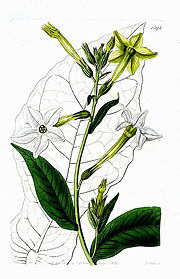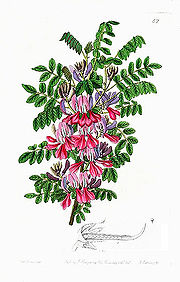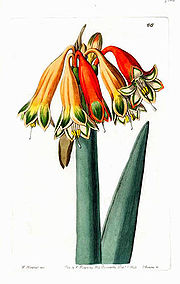
Sydenham Edwards
Encyclopedia



Edwards was born in 1768 in Usk
Usk
Usk is a small town in Monmouthshire, Wales, situated 10 miles northeast of Newport.The River Usk flows through the town and is spanned by an ancient, arched stone bridge at the western entrance to the town. A castle above the town overlooks the ancient Anglo-Welsh border crossing - the river can...
, Monmouthshire
Monmouthshire
Monmouthshire is a county in south east Wales. The name derives from the historic county of Monmouthshire which covered a much larger area. The largest town is Abergavenny. There are many castles in Monmouthshire .-Historic county:...
, the son of Lloyd Pittell Edwards, a schoolmaster and organist, and his wife, Mary Reese, who had been married on 26 September 1765 at Llantilio Crossenny Church and where Sydenham was christened in 1768. Mary Reese was a sister of the Rev. William Reece, the curate of Llantilio Crossenny who had married Ann Mackafee. Their son, Richard Reece was an eminent physician and wrote a number of works on medicine. Young Edwards had a precocious talent for draughtsmanship and when only 11 years old had copied plates from Flora Londinensis
Flora Londinensis
Flora Londinensis is a book that described the flora found in the London region of the mid 18th century. The Flora was published by William Curtis in six large volumes...
for his own enjoyment. A certain Mr. Denman, visited Abergavenny
Abergavenny
Abergavenny , meaning Mouth of the River Gavenny, is a market town in Monmouthshire, Wales. It is located 15 miles west of Monmouth on the A40 and A465 roads, 6 miles from the English border. Originally the site of a Roman fort, Gobannium, it became a medieval walled town within the Welsh Marches...
in 1779 and saw some of Edwards' work. Denman, being a friend of William Curtis
William Curtis
William Curtis was an English botanist and entomologist, who was born at Alton, Hampshire.Curtis began as an apothecary, before turning his attention to botany and other natural history. The publications he prepared effectively reached a wider audience than early works on the subject had intended...
, the publisher of botanical works, and founder of the Curtis's Botanical Magazine
Curtis's Botanical Magazine
The Botanical Magazine; or Flower-Garden Displayed, is an illustrated publication which began in 1787. The longest running botanical magazine, it is widely referred to by the subsequent name Curtis's Botanical Magazine....
, spoke to Curtis about the boy. Curtis proceeded to have Edwards trained in both botany and botanical illustration.
Edwards' illustrations turned out to be enormously popular. He flourished during a period when adventure-filled collecting expeditions were made to previously unknown corners of the earth. These expeditions gripped the public imagination and the desire for new plants and illustrations seemed to be endless. Against this backdrop Edwards produced plates at a prodigious rate: between 1787 and 1815 he produced over 1,700 watercolours for the Botanical Magazine alone. He illustrated Cynographica Britannica 1800 (an encyclopaedic compendium of dog breeds in Britain), New Botanic Garden 1805-7, New Flora Britannica 1812, and The Botanical Register
The Botanical Register
The Botanical Register, subsequently known as Edwards's Botanical Register, was an illustrated horticultural magazine that ran from 1815 to 1847. It was started by the botanical illustrator Sydenham Edwards, who had previously illustrated The Botanical Magazine, but left after a dispute with the...
1815-19. Edwards established the latter under his own editorship in 1815 after a disagreement with John Sims, who succeeded Curtis as editor. He also provided drawings for encyclopaedias such as Pantologia
Pantologia
Pantologia was an English encyclopedia, published in 12 volumes, 8vo in 1813, with 370 plates . Its full title page was A New Cyclopedia, comprehending a complete series of Essays, Treatises and Systems, alphabetically arranged, with a general dictionary of Arts, Sciences and Words: the whole...
and Rees's Cyclopaedia
Rees's Cyclopaedia
Rees's Cyclopædia, or The New Cyclopaedia, or, Universal Dictionary of the Arts and Sciences was an important 19th Century encyclopaedia which was regarded by some as subversive when it first appeared. It was edited by Revd...
. He completed a number of parrot illustrations between 1810 and 1812 which were acquired by Edward Smith-Stanley, 13th Earl of Derby
Edward Smith-Stanley, 13th Earl of Derby
Edward Smith-Stanley, 13th Earl of Derby KG , styled Lord Stanley from 1776 to 1832 and known as The Lord Stanley from 1832 to 1834, was an English politician, landowner, builder, farmer, art collector and naturalist...
. Edwards was a Fellow of the Linnean Society.
Edwards's work was the inspiration of the decoration of ceramics made by a number of major potters of the time, such as Spode
Spode
Spode is a well-known English brand of pottery and homewares based in Stoke-on-Trent.- The overview :Spode is a Stoke-on-Trent based pottery company that was founded by Josiah Spode in 1770...
.
He was buried at Chelsea Old Church (All Saints), London.
There is confusion over the spelling of his middle name. He was baptised Sydenham Edwards, but by the 1790s adopted the middle name 'Teak' on some of the signatures of his drawings. His death certificate has this as 'Teaste', whereas his tombstone, in Chelsea Old Church, it was 'Teast'. The tombstone was destroyed by bombing in World War Two, but has been replaced.
External links
- Biography of Curtis and contemporaries
- View digitized titles by Sydenham Edwards in Botanicus.org
- Garden Flowers by Sydenham Edwards et al.
- Works in the collection of the Museum of New Zealand Te Papa Tongarewa

